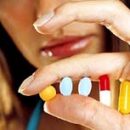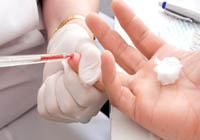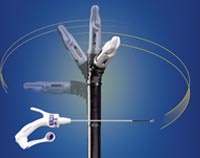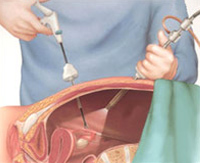General urine analysis is one of the most common research methods. During the study, urine doctors pay attention to its physical characteristics, the chemical composition and study the blades under the microscope.
Content
- Urine reaction (pH)
- Protein (Pro)
- Glucose (GLU)
- Nitritics (NIT)
- Bilirubin (BIL)
- UBG (UBG)
- Ketone Body (KET)
- Hemoglobin (HB)
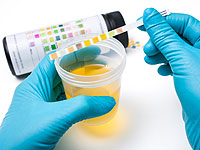 From the parameters of the chemical composition, the most important is the content of protein, glucose, nitrites, bilirubin, urobilineogen, ketone bodies, hemoglobin, as well as the definition of pH.
From the parameters of the chemical composition, the most important is the content of protein, glucose, nitrites, bilirubin, urobilineogen, ketone bodies, hemoglobin, as well as the definition of pH.
Urine reaction (pH)
For urine normal is a weakly acidic reaction, but this figure can vary within 4.5-8. Low-minded reaction — Normal for people, the diet of which contains a large amount of greenery, fresh fruit. But more often such a picture is observed in patients after abundant vomiting, increase potassium levels in blood, hyperparathyroidism, long-term intake of diuretics. Reduced pH may be a consequence of dehydration, diabetes, chronic renal failure, urolithiasis or fever.
Protein (Pro)
Normally, the protein concentration in the urine is less than 0.002 g / l. The appearance of protein in the urine is called proteinuria. Sometimes proteinuria is not a consequence of the disease, for example, it happens after intensive physical work, stress, eating a large amount of protein, poor-quality toilet of genital organs before the sample fence.
But, unfortunately, the appearance of a protein in the urine most often indicates the presence of certain pathologies. Normally, proteins are not moving out of blood in the urine, but for the disease of the kidneys (glomerulonephritis, pyelonephritis, nephropathy of pregnant women), as well as fever, hypertension The filtration barrier is broken. With inflammation of the organs of excretory and sexual systems (cystitis, urethritis, prostatites, vaginites), protein will also appear in the urine.
Glucose (GLU)
Normally, almost all glucose that fell into the urine, when it passes through the renal channels, it is absorbed back into the blood. Therefore, healthy people do not find sugar in the blood. A significant increase in blood glucose (with diabetes mellitus) or a disruption of its reverse absorption during renal diabetes leads to glucose — The appearance of blood sugar.
Nitritics (NIT)
Healthy people do not have. They are formed as a result of the vital activity of some bacteria that turn nitrate nitrates. Therefore, their presence speaks of a bacterial damage to the urinary tract.
Bilirubin (BIL)
Is not a normal urine component. Bilirubin is continuously formed in our organism in the destruction of red blood cells. Such bilirubin is very toxic and called direct. In the blood, it binds to the albumin protein, synthesized in the liver, is transported to it and under the influence of chemicals turns into non-toxic indirect bilirubin. Next, together with bile, it enters the intestinal lumen and turns into intestinal bacteria in Urobilinogen. It is clear that with the damage to the liver or the difficulty of the outflow of the bile, the whole cycle is disturbed, and the content of indirect bilirubin in the blood increases, which leads to the appearance of it in the urine. But the direct bilirubin through the renal filter does not pass, so with the increased destruction of red blood cells, bilirubin is rarely appeared in the urine.
UBG (UBG)
The normal level of urobinogen is considered to be concentration to 10 mg / l. We have already mentioned that this pigment appears due to the processing of bilirubin intestinal bacteria. The resulting urobilinogen is absorbed into the blood and is excreted from the body with urine. Elevated decay of the erythrocytes (hemolytic anemia, poisoning by some poisons), inflammation of the intestine of bacterial origin causes reinforced products of urobilinogen, and therefore the emergence of a significant amount of it in the urine. In addition to these reasons, the high concentration of urobilinogen is observed in patients with liver diseases.
Ketone Body (KET)
Ketone bodies are formed in the body when disintegrating fats, and their content in the blood, and therefore in the urine, so insignificant that is not determined by the equipment. Therefore, it is believed that healthy people are no ketone bodies in the urine. The main source of energy for the body is glucose, if it is not sufficient (fasting), the body requires significant energy costs (fever) or glucose can be absorbed by cells (diabetes mellitus), the fats are used to obtain. As a result, the production of ketone bodies and the appearance of them in the urine (Ketonuria). In children content «glucose stock» Glycogen is very small. Therefore, even a slight subframe can lead them to Ketonuria.
Hemoglobin (HB)
Until a certain concentration in the blood, hemoglobin does not penetrate the urine, so there is no. In healthy people, the content of this protein in the blood is low, t.To. Hemoglobin formed by the destruction of red blood cells, has time to recycle the organism on simpler components. But with the increased decay of the red blood cells, and this may be due to the poisoning of hemolytic poisons, many infectious diseases (malaria, typhoid, difftheria, scarlet nature), burns, sepsis and even long walk he does not have time to dispose, its concentrations in the blood rises, and it appears in the urine.

